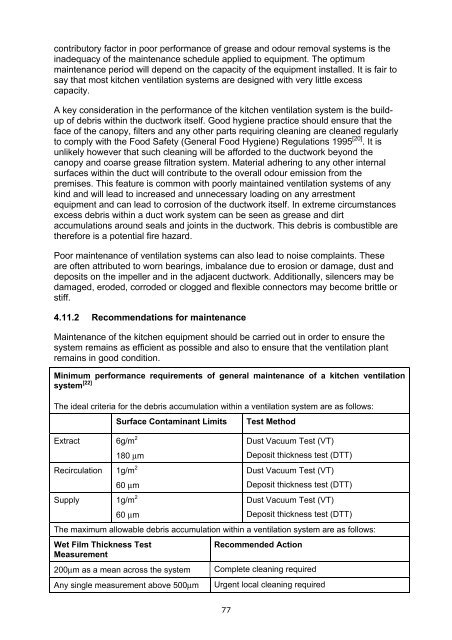Guidance on the Control of Odour and Noise from ... - Defra
Guidance on the Control of Odour and Noise from ... - Defra
Guidance on the Control of Odour and Noise from ... - Defra
Create successful ePaper yourself
Turn your PDF publications into a flip-book with our unique Google optimized e-Paper software.
c<strong>on</strong>tributory factor in poor performance <strong>of</strong> grease <strong>and</strong> odour removal systems is <strong>the</strong><br />
inadequacy <strong>of</strong> <strong>the</strong> maintenance schedule applied to equipment. The optimum<br />
maintenance period will depend <strong>on</strong> <strong>the</strong> capacity <strong>of</strong> <strong>the</strong> equipment installed. It is fair to<br />
say that most kitchen ventilati<strong>on</strong> systems are designed with very little excess<br />
capacity.<br />
A key c<strong>on</strong>siderati<strong>on</strong> in <strong>the</strong> performance <strong>of</strong> <strong>the</strong> kitchen ventilati<strong>on</strong> system is <strong>the</strong> buildup<br />
<strong>of</strong> debris within <strong>the</strong> ductwork itself. Good hygiene practice should ensure that <strong>the</strong><br />
face <strong>of</strong> <strong>the</strong> canopy, filters <strong>and</strong> any o<strong>the</strong>r parts requiring cleaning are cleaned regularly<br />
to comply with <strong>the</strong> Food Safety (General Food Hygiene) Regulati<strong>on</strong>s 1995 [20] . It is<br />
unlikely however that such cleaning will be afforded to <strong>the</strong> ductwork bey<strong>on</strong>d <strong>the</strong><br />
canopy <strong>and</strong> coarse grease filtrati<strong>on</strong> system. Material adhering to any o<strong>the</strong>r internal<br />
surfaces within <strong>the</strong> duct will c<strong>on</strong>tribute to <strong>the</strong> overall odour emissi<strong>on</strong> <strong>from</strong> <strong>the</strong><br />
premises. This feature is comm<strong>on</strong> with poorly maintained ventilati<strong>on</strong> systems <strong>of</strong> any<br />
kind <strong>and</strong> will lead to increased <strong>and</strong> unnecessary loading <strong>on</strong> any arrestment<br />
equipment <strong>and</strong> can lead to corrosi<strong>on</strong> <strong>of</strong> <strong>the</strong> ductwork itself. In extreme circumstances<br />
excess debris within a duct work system can be seen as grease <strong>and</strong> dirt<br />
accumulati<strong>on</strong>s around seals <strong>and</strong> joints in <strong>the</strong> ductwork. This debris is combustible are<br />
<strong>the</strong>refore is a potential fire hazard.<br />
Poor maintenance <strong>of</strong> ventilati<strong>on</strong> systems can also lead to noise complaints. These<br />
are <strong>of</strong>ten attributed to worn bearings, imbalance due to erosi<strong>on</strong> or damage, dust <strong>and</strong><br />
deposits <strong>on</strong> <strong>the</strong> impeller <strong>and</strong> in <strong>the</strong> adjacent ductwork. Additi<strong>on</strong>ally, silencers may be<br />
damaged, eroded, corroded or clogged <strong>and</strong> flexible c<strong>on</strong>nectors may become brittle or<br />
stiff.<br />
4.11.2 Recommendati<strong>on</strong>s for maintenance<br />
Maintenance <strong>of</strong> <strong>the</strong> kitchen equipment should be carried out in order to ensure <strong>the</strong><br />
system remains as efficient as possible <strong>and</strong> also to ensure that <strong>the</strong> ventilati<strong>on</strong> plant<br />
remains in good c<strong>on</strong>diti<strong>on</strong>.<br />
Minimum performance requirements <strong>of</strong> general maintenance <strong>of</strong> a kitchen ventilati<strong>on</strong><br />
system [22]<br />
The ideal criteria for <strong>the</strong> debris accumulati<strong>on</strong> within a ventilati<strong>on</strong> system are as follows:<br />
Extract<br />
Surface C<strong>on</strong>taminant Limits Test Method<br />
6g/m 2<br />
180 µm<br />
Recirculati<strong>on</strong> 1g/m 2<br />
Supply<br />
60 µm<br />
1g/m 2<br />
60 µm<br />
77<br />
Dust Vacuum Test (VT)<br />
Deposit thickness test (DTT)<br />
Dust Vacuum Test (VT)<br />
Deposit thickness test (DTT)<br />
Dust Vacuum Test (VT)<br />
Deposit thickness test (DTT)<br />
The maximum allowable debris accumulati<strong>on</strong> within a ventilati<strong>on</strong> system are as follows:<br />
Wet Film Thickness Test<br />
Measurement<br />
Recommended Acti<strong>on</strong><br />
200µm as a mean across <strong>the</strong> system Complete cleaning required<br />
Any single measurement above 500µm Urgent local cleaning required
















